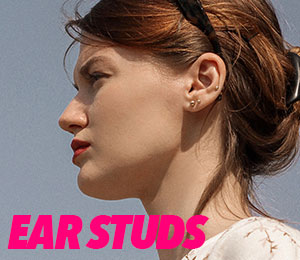 Pierceoff News
Pierceoff News
How to Treat an Infected Piercing: A Guide by Experts!
Many of us will know the excitement of having a new body piercing, and the worry when it starts to show signs of infection! Around 10-30%...

FREE SHIPPING (when you spend over $50)*

Experts in Body Jewellery & Piercing

Excellent Trust Pilot Rating

Easily the most common of body piercings, the earlobe piercing is one of the most widely accepted forms of body modifications and one that the majority of people first start with. When we talk of lobe piercings we normally refer to piercings placed directly in the centre of the lobe and this can extend from one to multiple piercings. However, variations in the form of traverse (horizontally through the lobe), vertical lobes and of course the stretched lobe are all included in the overall grouping of lobe piercings.
The standard form of the lobe piercing is one of the least painful to get and one of the easiest to care for in terms of healing. Additionally, the healing time tends to be one of the quickest when a good aftercare regime is in place, generally 6 to 8 weeks. Obviously we recommend going to a professional piercer (that pierces with needles) as they can not only give you a safe piercing but also provide you with professional aftercare advice.
.jpg) |
.jpg) |
.jpg) |
Earlobe piercings are extremely versatile with so many possibilities and jewellery available. Generally most lobe piercings are performed around the 1.0mm (18ga) or 1.2mm (16ga) size. Most of us are familiar with the common earring stud with a butterfly back (which we offer here) but in body piercing circles barbells, rings (ball closure rings, segment and circular barbells) or labret-style jewellery are the standard. These can come variety of different tops, from claw-set jewels gems to plain balls and in many different materials as well. Having said that, sticking to titanium or high quality surgical stainless steel is advised to avoid any issues relating to allergic reactions.
 |
Ear StudsEar Studs are the classic option for ear lobe piercings. Whether it is a smooth ball stud or a beautiful clawset crystal for something special, there is an ear stud for all occasions. |
 |
Hinged Segment RingsHinged Segment Rings are the perfect option when you want a complete hoop that is easy to insert and remove. The hinged mechanism makes opening and closing the ring a cinch! |
 |
PlugsThe staple for any stretched lobe (or piercing for that matter), plugs come in a huge variety of materials and styles. Top tip: Wood plugs are great for healed stretched lobes, comfortable and natural! |
Ear piercing in general has been a practice dating all the way back to Ancient times. In fact on the oldest mummified body found to date, the 5,300 year old Ötzi the Iceman had evidence of pierced ears. Additionally, the oldest earrings have been found in a grave dating 2500 BCE. There are many artistic and written references to earrings from many of the ancient civilisations (Sumerian, Minoan and Lothal) as well as many biblical references to earrings.
A general recurrent theme of a sign of nobility and weath (as with most jewellery) has existed over the ages, although again the ear piercing has always seemingly survived amongst the common. Particular reasons for ear piercings are sailors, who held the superstition that piercing one ear would improve eyesight or the gold or silver pay for their burial if their body was washed up on shore for other cultures or periods of history it was purely a fashion article. Earrings have passed in and out of fashion amongst different groups throughout the ages but in the modern ages starting in the 1960s ear piercing has gained popularity and acceptance across society to the level we find it at today.
Wikipedia Ear Piercing https://en.wikipedia.org/wiki/Body_piercing#Ear_piercing retrieved 25th February 2021
Photo by ian dooley on Unsplash
Photo by Wilson Vitorino from Pexels
Photo by cottonbro from Pexels
Photo by Maksim Goncharenok from Pexels
Photo by kyle smith on Unsplash
Photo by Ralph Rabago from Pexels
Photo by Etty Fidele on Unsplash
 Pierceoff News
Pierceoff News
Many of us will know the excitement of having a new body piercing, and the worry when it starts to show signs of infection! Around 10-30%...
 Pierceoff News
Pierceoff News
It should come as no surprise that getting pierced can hurt - after all, you’re making a hole in your body! But not all piercings are cr...
 Pierceoff News
Pierceoff News
Nose piercings are notorious for taking a while to fully heal – in fact, most experts say it takes up to 6 months. During this time, itchine...
 Pierceoff News
Pierceoff News
Nothing kills the excitement of having a new piercing faster than seeing signs of an infection. More than just being painful, an infected pi...